Wall drainage around the house itself
The presence of water at the dacha - a guarantee of a good harvest. But its excessive amount can do more harm than good. It is about groundwater. Their excess can cause damage not only to the harvest, but also to all buildings. Water can erode the foundation of the house, flood the basement. In the living room will begin to rot floors, and the house will go mold. But you can save yourself from this trouble by building wall drainage around the house with your own hands. Let's take a closer look at the solution to this problem.
Under what conditions is drainage necessary?
The conditions for the need for the construction of wall drainage according to SNiP are as follows:
- basements, floors, various communications are below the groundwater level, or the floors of the building are located less than 50 cm from the water;
- regardless of the groundwater level, the basement structures are located in clay soil.
Species
Before the construction of wall drainage, it is necessary to study the soil and the depth of groundwater. It depends on what type of drainage you will build:
- If the groundwater is deep, and your site is affected only by rainwater and spring snow melt, you need surface drainage around the building.
- When your building suffers from a high location of groundwater, you need deep drainage.
The owner of the house, whose building is located on sandy soil, you can not worry about the construction of drainage. As is known, sandy soil absorbs water well and, one can say, it itself performs the function of drainage. But not everyone is so lucky. So let's consider each type of wall drainage separately.
Open type
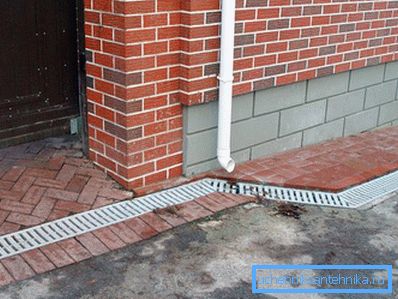
This type of wall drainage is considered the simplest construction and requires almost no construction costs. But because of the simplicity of the device, such drainage is not durable. Over time, the walls of the trench can fall off, and it takes up a certain area on which it is impossible to break a flowerbed or sow lawn grass. For the owner of a small house, which does not have extra funds for the construction of expensive drainage, this construction will be a salvation from excess water. Let's take a look at how to do it:
- Plan the ground around the house, draw a plan for the passage of trenches and installation of water wells.
- According to the plan outlined, start digging trenches. Dig the drainage trench along the entire perimeter of the building, keeping the slope in the direction of the drain approximately 2 cm per 1 m long unit.
- The drain from the drainage trench will be made in a drainage trench, which is dug near the catchment, but a little deeper. The width and depth of the trenches are taken arbitrarily so that they contain the volume of wastewater. To save space, the drainage trench can be dug on one side of the building, then in the drainage trench it is necessary to direct all slopes towards one drainage trench.
- A small transverse ditch is dug between the walls of two trenches to connect them. To perform the connection, you can use sewer pipes with a diameter of 110 mm. If there is no pipe, you can leave the connection with a dug across the trench.
- At the edge of the drainage trench, dig out a water intake well, from which water will be drained into a ravine or pumped out. The well must be airtight, with a concreted bottom. If drainage trenches are excavated around the entire perimeter of the building, then water intake wells should be installed at all four corners of the building.
- Cover the finished trench and intake wells with bars.
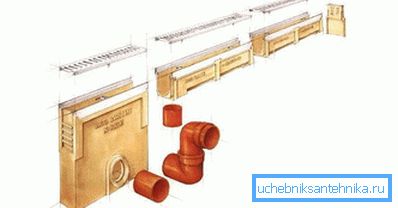
Your simplest wall drainage is ready. Rain and melt water will fall into the drainage trench and randomly run down the drainage trench along a slope. And already from the drainage trench - directly into the water intake well.
Deep drainage
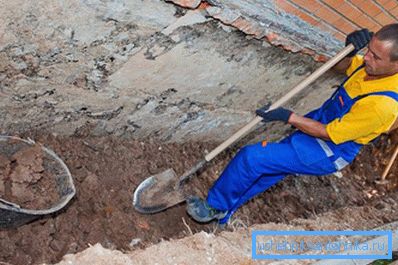
This type of wall drainage is considered the most functional and durable compared with the previous type. Deep drainage is placed around the ring around the building. Its depth should be at least 50 cm below the foundation cushion, and the distance from the building wall should be at least 3 meters. The slope of the wall drainage in the direction of the drain must be at least 1 cm per 1 m of linear traffic, which is 1%. To perform a slope calculation, the location of the lower point of the drain and the highest point of the drainage, which is located at the corner of the building, is taken. Measure the distance between these points and set a slope of 1%.
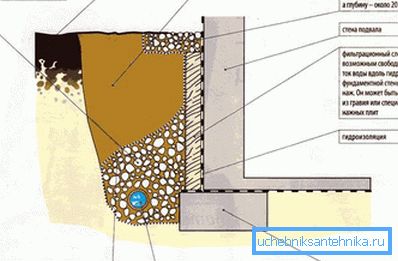
Now let's look at the process of building deep drainage:
- You dig a trench around the building to the required depth and about 40 cm wide.
- On the trench mark the location of the manholes and also dig holes for them. Wells should be located at a distance of 20 m from the turn of the pipe, and on a straight section - every 40 meters.
- Perform the installation of wells. They must be airtight, with a concrete bottom. For their construction use concrete rings, cinder block, or buy ready-made plastic.

- Level the bottom of the trench with a bias towards the discharge and lay geotextiles.
- Pour a layer of rubble about 15 cm and lay the drainage pipe. The drain pipe must be tightly connected and lie on the calculated slope in the direction of the drain. The entrance of the pipe into the concrete well is well sealed with cement.
- If you want, you can connect all drains to the drain pipe. Just put the filters from falling debris.
- Drain the water. If the test went well and all the water has drained, proceed to the isolation of the drainage. Cover the top of the pipe with rubble and wrap the remaining edges of the geotextile fabric. You should have a pipe in a layer of rubble wrapped in a sheet.
- Wrap the pipe from the top to fall asleep with a small layer of sand and the remaining soil. The whole site is leveled.
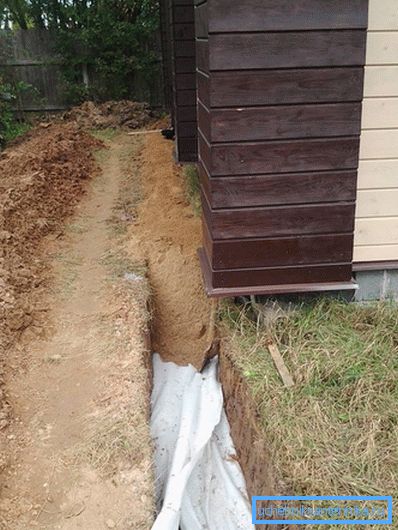
On this construction of wall drainage is considered completed. Clean the wells and water pumping in time, in case of impossibility of arbitrary discharge into the ravine. The deep wall drainage model will serve you for many years, saving your home from the harmful effects of groundwater.
Video
See how wall drainage is done:
See also:
Reservoir drainage
Surface drainage area
How to make a drainage well
What rubble is needed for drainage